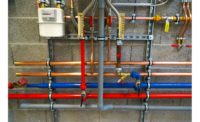More HVAC contractors are adding plumbing as a way to better serve their customers and smooth out demand for services through the year. Making the addition, however, requires proper planning and realistic expectations.
Flame Furnace in Warren, Michigan, added plumbing about five years ago. Matt Marsiglio, Flame’s operations manager, said the firm wanted to expand the services it offers consumers.
“We thought it would be a pretty simple transition to provide a one-stop shop for our customers,” Marsiglio said.
It wasn’t. The learning curve proved steeper than excepted, Marsiglio said. The biggest difference came from the pace of plumbing work versus HVAC. Flame targets five service calls per technician each day on the HVAC side. System replacements usually take a few days, so technicians visit several homes and then return when parts arrive. In the plumbing business, a full day consists of two or three calls since many repairs require immediate action.
As a result, stocking parts for a plumbing/HVAC company creates a challenge. Plumbing uses fewer universal parts than HVAC, Marsiglio said, so inventorying a truck is more difficult. Some supply houses stock parts for both plumbing and HVAC, but many dedicate themselves to only one line. Marsiglio said Flame needed to make new contacts on the plumbing side of the supply house business. The company also gave credit cards to its plumbers so they can make supply house purchases on their own.
Flame added several large trucks to fit piping and other equipment. These new trucks bear their own logo. The plumbing trucks display a water image rather than the flame image found on the HVAC trucks.
HVAC Contractors Used Plumbing Partners Before Going In-House
Flame referred a lot of business to a local plumbing firm before taking the services in-house. So had TR Miller Heating and Cooling, an HVAC and, as of June 1, plumbing contractor in Plainfield, Illinois. Brian Sloan, TR Miller’s president, said the outside company had a good reputation, but he still received some feedback from unhappy customers. Sloan decided he wanted control over the outcome of a service call.
“They were upset at us because the company we referred didn’t provide great service,” Sloan said. “I can’t fix what they broke.”
Sloan started planning to add plumbing three years ago. He originally set 2022 as his goal. By 2019, he had moved the date to July 2020. Then came the coronavirus crisis. During the first quarter review, TR Miller leadership decided to make the move as soon as possible. That turned out to be the beginning of June, due to the state of Illinois’ shutdown.
That demonstrates one of the biggest hurdles for HVAC contractors getting into plumbing — licensing. In Illinois, a plumbing contractor’s license requires having a licensed plumber on staff as a company officer. Sloan said finding a good licensed plumber who fits TR Miller’s culture requires a lot of searching. It’s somewhat easier to find lower level plumbing staff, but Illinois limits each plumber to two apprentices. It takes four to five year for a plumbing license in Illinois, Sloan said.
Flame also uses the licenses of its master plumbers. Michigan does allow water heater improvements under a mechanical contractor’s license, so the firm has more leeway there. Flame is always recruiting plumbers, Marsiglio said. The firm currently employs three plumbers. It’s been twice that number in the past, and they hope to get to five.
Creating Whole Home Solutions for Customers
Buying an existing plumbing company solves most of these start-up problems. That’s what Goettl Air Conditioning and Plumbing did. The company consolidates HVAC companies through acquisitions and started buying plumbing firms last year and added plumbing to its name.
“We wanted to provide our customers with quality whole-home solutions,” said Zach Hunt, Goettl’s plumbing manager. “Adding plumbing services was a natural addition to our already robust offerings.”
The idea of providing a whole-home solution expanded Goettl’s vision of how it serves its customers, Hunt said. The company now offers an inspection that including HVAC and plumbing and identifies problems before they grow out of hand.
“Doing the whole-home inspection saves them from having to schedule multiple appointments with multiple companies, reducing the time they take off work, and helps them do preventative repairs, reducing the chance for things like flooding and backup pipes,” Hunt said.
Goettl handles these calls through one dedicated call center. The administrative side is crucial to a successful expansion into plumbing, Sloan said. He started looking for people on the before hiring the first plumber. The woman who now runs TR Miller’s call center came to them with 10 years of experience at a plumbing company. She helped them decide what services to get into and what questions to ask customers, Sloan said.
“If you’re not collecting the proper information and are sending your technicians into a call blind, then your return on investment decreases because you want have the right products or the right technicians for the job,” he said.
Consumers Already Think HVAC Contractors Offer Plumbing
Sloan plans to add a plumbing truck per quarter for the next year. He said he can keep two or three trucks busy without much marketing. By January 1, they’ll start marketing plumbing services to their maintenance contract customers and then seek out new customers.
Many consumers think a home service company can do anything, and they seek out the ones they trust. Most of the company’s growth now is organic, Sloan said. He was surprised to find that “tr miller plumbing” was the fourth most popular search query for his company even before they added plumbing.
Sloan wants to grow the business at a rate where the company avoid exceeding its capabilities. For example, TR Miller won’t do any sewer or mainline work before the end of the year.
Marsiglio said Flame’s HVAC techs give out cards that announce the firm now offers plumbing and includes a discount offer. Flame includes a plumbing category on its blog. Overall, though, the firm still spends a relatively small amount on advertising for its plumbing services, mainly because HVAC produces a much greater share of revenue.
Sloan said he only expected plumbing to provide some revenue. Adding the trade only required a small amount of operating capital, Sloan said. Plumbing and HVAC share many tools, and most customer management systems function well for both services. Sloan likes the return on investment so far. One of his main goals is a steadier stream of revenue without the spikes and valleys of heating and cooling.
“For me, it was about diversifying our portfolio,” Sloan said.
New Plumbing Processes Improve HVAC Practices
Adding plumbing also adds new processes that can benefit an HVAC contractor in other ways. For example, Marsiglio said plumbers are better at using personal protective equipment because they deal with high-risk contamination all the time. This became valuable during the pandemic.
Sloan recommends putting considerable time into preparing for the addition of plumbing. He said HVAC contractors looking to expand need to create a plan and set a budget. Both Sloan and Marsiglio advice seeking input from either other HVAC contractors that offer plumbing or plumbing contractors. Marsiglio found help through his ACCA MIX Group, while Sloan consults with a large plumbing contractor in Ohio. That contractor helped TR Miller build out its price book and set its services so the firm knew what materials were needed.
Sloan said the most important advice he could give another HAVC contractor adding plumbing is to admit what they don’t know.
“If I acted like I knew everything about plumbing, my plumbers would not be as receptive to me as a leader,” Sloan said.
“We wanted to provide our customers with quality whole home solutions. Adding plumbing services was a natural addition to our already robust offerings.” Zach Hunt.











